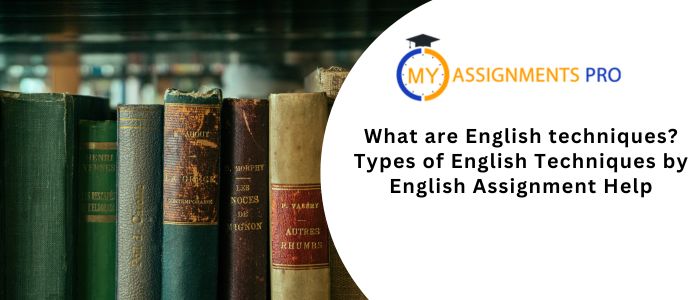
What are English techniques? Types of English Techniques by English Assignment Help
To engage the audience, arouse feelings, and transmit meaning, authors, and presenters must employ English tactics. Whether you're writing a speech, essay, or poetry, knowing and using English grammar rules may improve your ability to communicate. These strategies are employed to highlight the beauty of language, establish attention, and organize ideas. They may assist you in modifying words and phrases to fit various literary, academic, and persuasive settings and goals. This blog shared by English Assignment Help will examine several English writing styles, their sorts, and how being proficient in them may help you write better. We'll also go over how English Assignment Help may help you apply these strategies successfully to succeed academically.
What Are English Techniques? Guide by All Assignment Help
English tactics are methods and resources that writers, presenters, and communicators use to improve their language and increase the impact, persuasiveness, and engagement of their messages. These methods aid in forming the presentation of information, impacting the audience's interpretation, response, and retention of the material. As per English assignment help, they provide a variety of techniques to express meaning, arouse emotions, and highlight certain topics, making them indispensable in both creative and academic writing.
English language skills may be applied in several settings, including ordinary communication, essays, presentations, and literature. They consist of rhetorical techniques, literary devices, and figures of speech that can give the text more nuance and originality. Students, authors, and communicators may produce more engaging, intelligent, and useful material by becoming proficient in these strategies. Metaphors, similes, alliteration, and rhetorical questions are a few examples; each has a special function in enhancing the vividness and impact of language.
Types of English Techniques: Learn From Our All Assignment Help
Based on their use and objective, English methods may be categorized into several groups. Some of the most popular English language strategies are listed below, each of which improves the effectiveness of writing and communication:
Figures of Speech
- A metaphor highlights the similarities between two unrelated objects by directly comparing them. For example, "Time is a thief," which means stealing moments from time.
- A simile is an analogy that contains words such as like or as. For example: "Her smile was as bright as the sun," which means that the brightness is bright.
- In personification, we offer an inanimate or abstract thing humanlike characteristics. For example: "The wind whispered through the trees."
- A hyperbole is an exaggeration that is meant to add effect or strength: "I have told you a million times." This suggests how many times a certain idea has been reiterated or emphasized.
Our all assignment help experts are always available for students to help with any kind of difficulties you might face.
Literary Devices
- Alliteration is the repetition of initial consonant sounds in words of the same line or string of phrases. "Peter Piper picked a peck of pickled peppers," for instance. It highlights the sentence and establishes a rhythm.
- Onomatopoeia refers to the fact of using words that imitate sounds associated with objects or actions. For instance, words such as 'buzz,' 'crash,' or 'clang' create in the readers an auditory image of the sounds that they denote.
- The discrepancy between expectations and what really happens. The three types of irony are situational irony, in which an unexpected event occurs; dramatic irony, where a character involved does not know what the audience knows; and verbal irony, where one says something other than he/she means.
- Symbolism is using symbols to present ideas or further meanings. An example of the above could be that a red rose symbolizes love.
If you are facing any issues in comprehending any subject matter or the topic, you can always opt for our all-assignment help services.
Rhetorical Devices
- An example of a rhetorical question is one where an answer is not expected but suggested. Such as, "Who doesn't like to be successful?" This highlights the idea and challenges the listener to reflect.
- Besides these tools above, there are others like repetition or reiteration where words or phrases may be repeated to deliver a point or rhythm, as when Martin Luther King Jr., in his now-famous speech, said over and over, "I Have a dream".
- For instance, anaphora is the repetition of a word or phrase at the start of each successive clause. For example: "We shall fight on the beaches, we shall fight on the landing grounds." in a speech by Winston Churchill.
- It concerns the contrast, bringing opposing ideas in the same sentence or phrase. For example: "The best of times, the worst of times."
Our all assignment help experts also conduct live sessions for students to clarify their doubts and queries regarding the assignment.
Syntax and Structure
- In order to provide a harmonic and balanced impact, parallelism is the use of the same grammatical structure in phrases or portions of sentences. An example might be "She enjoys swimming, writing, and reading."
- Chiasmus is the technique of flipping the word order of two parallel phrases to produce irony or a feeling of balance. As an illustration, "Never allow a fool to kiss you or let a kiss fool you."
- Ellipsis is the practice of leaving out words that are understandable in context; it's frequently employed to build tension or a feeling of mystery. An example of this might be "I was going to the store, but then....," which suggests that something unexpected occurred.
Narrative Techniques
- A flashback is a sequence of events that pauses the current action to recall a previous occurrence. This can give crucial background information or context.
- Foreshadowing is the practice of revealing details or suggestions about future plot points. A character could see, for instance, that dark clouds are accumulating, hinting at an approaching storm.
- The first, second, or third-person point of view is the one from whom the tale is conveyed. The reader's ability to relate to the characters is influenced by each point of view, which provides unique insights into the story.
How to Use English Techniques in Your Assignments? Hear From All Assignment Help
The quality and impact of your writing can be greatly improved by incorporating English writing skills into your projects. These strategies engage your audience and improve the way you communicate your ideas, whether you're writing an essay, report, or creative article. Here are some ways to improve your assignments using English techniques:
Enhance Descriptions with Imagery
Create vivid mental images for the reader by using imagery. The experience can be made more intimate and valuable by using the five senses: sight, sound, smell, touch, and taste. An example will illustrate how a word can make the reader see what you are describing. Here is an example: "The golden rays of the morning sun stretched across the dew-covered grass."
Incorporate Figurative Language for Impact
Similes and metaphors are effective ways to draw parallels that your readers will find compelling. They have the power to humanize abstract concepts. For instance, "Her voice was like a melody," which doesn't require any explanation, evokes a sense of harmony and beauty right away. You can connect with our all assignment help experts through guided sessions to get a better understanding of the subject matter.
Use Alliteration and Assonance for Rhythm
Alliteration applies repetitive consonant sounds, while assonance enables repeated vowel sounds which surely can encourage your writing to flow rhythmically. They increase the memorability and interest of your information. For instance, "The smooth sail of the ship," and "The eager eyes of the audience."
Add Emphasis with Repetition
One of the best ways to highlight important concepts in your project is through repetition. You may highlight crucial ideas for the reader by repeating keywords or phrases. For example, "Now is the time. This is the opportunity you've been seeking.
Use Irony for Effect
By contrasting what is expected with what occurs, irony—especially situational or verbal irony—can add intrigue to your work. As per all assignment help, it may draw attention to significant topics and provide levels of significance. To add an ironic twist to the story, you could, for instance, write a scenario in which everything that may go wrong does.
Create Suspense with Foreshadowing
Foreshadowing is hinting at future events in writing. You may create suspense and maintain the reader's interest by revealing little details. A character who perceives a storm approaching, for instance, may be hinting at an impending mental or physical storm.
Refine Structure with Parallelism
To make your writing balanced and fluid, use parallelism. This strategy employs comparable phrase or clause structures to improve readability and establish rhythm. "She loves reading, writing, and painting," for instance, preserves a harmonic and well-balanced sentence structure.
Use Rhetorical Questions to Engage Readers
Rhetorical inquiries enhance consideration of a topic in readers' minds, without requiring a direct response. They stimulate the reader's thoughts and promote introspection. For example, "What is the point of hard work if we don’t pursue our passion?" This method might help highlight a point or present a novel idea. Our all assignment help also create samples for students to refer to for writing better English assignments.
Leverage Symbolism for Deeper Meaning
You may add layers of significance to your work by using symbolism. You strengthen your arguments by giving things, people, or occasions a greater meaning. For instance, a "broken mirror" might represent a shattered sense of self or identity.
Edit for Clarity and Precision
Similes and metaphors can give your writing a touch of finesse, but ensure that your reader's head does not spin in the process. Aim for equilibrium by revising your work to make it more precise and clear. Don't utilize too many sophisticated tactics in a single paragraph or section. To improve meaning without confusing your readers, include them in your work instead.
Anyone who wants to create projects that are powerful and captivating must become proficient in English. These strategies, which range from strong imagery to rhetorical tricks, improve the caliber of your writing and increase its effectiveness, memorability, and engagement. You can enhance your academic achievement and acquire abilities that will help you in your professional and creative writing pursuits by comprehending and using these resources.
Our All Assignment Help is available if you need professional assistance or are having trouble incorporating these strategies into your papers. Our experts offer individualized support to help you understand and use these ideas successfully. We are committed to helping you succeed academically, whether that means writing essays, evaluating literature, or improving your writing style. With our knowledgeable advice, realize your full potential and advance your responsibilities!



